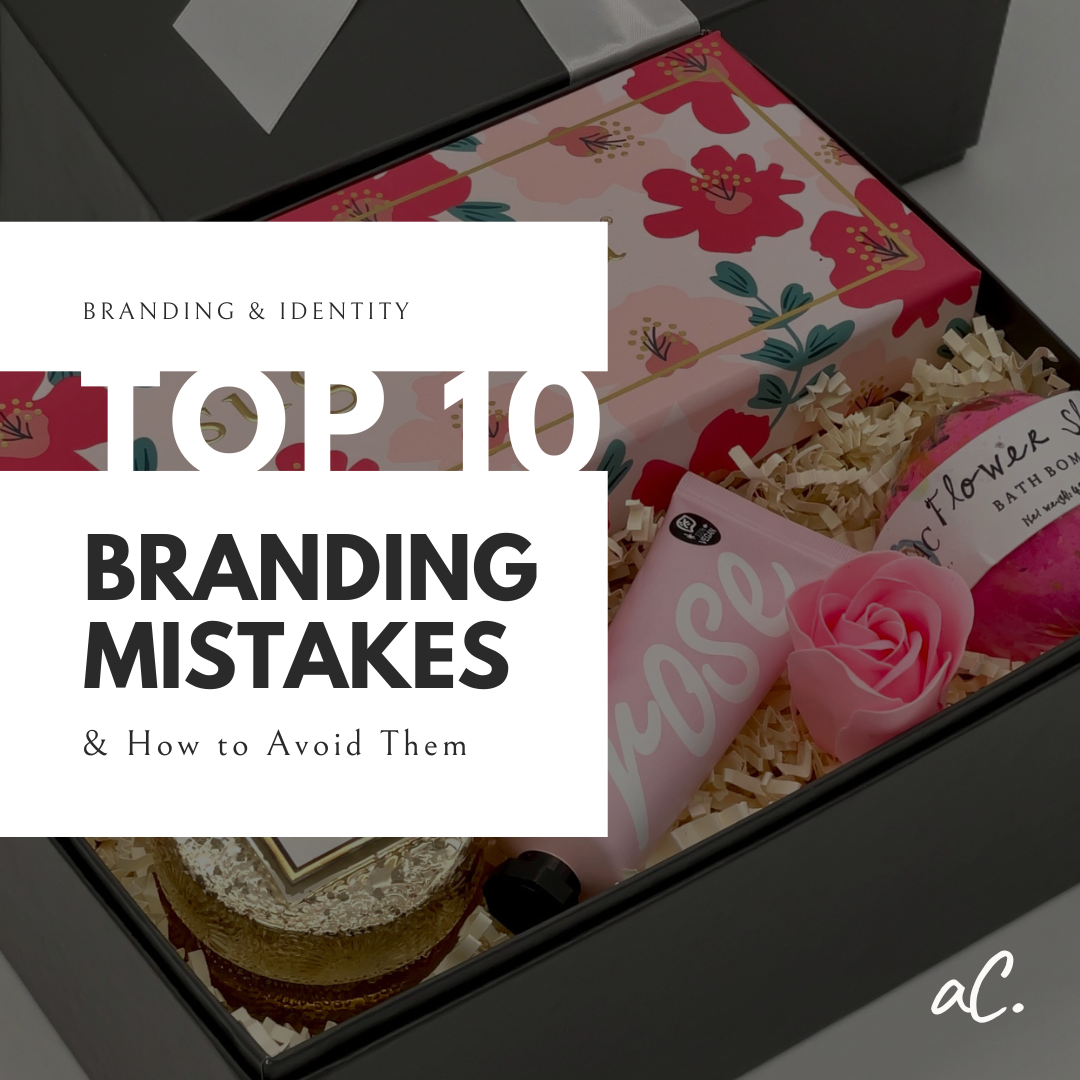
Branding & Identity
Top 10 Branding Mistakes & How to Avoid Them
Explore top tips on how to avoid branding mistakes and ensure your brand remains strong, consistent, and impactful.
In today’s competitive market, a strong brand is essential for standing out and attracting loyal customers. However, many businesses fall into common branding traps that can undermine their efforts.
Mistake 1: Inconsistent Branding
Inconsistent branding occurs when a brand’s message, visual identity, or tone varies across different platforms and touch points. This inconsistency can confuse customers and weaken the brand’s impact.
For example, a company that uses different logos or color schemes on its website and social media profiles may appear unprofessional and disorganized. Inconsistency will also weaken your brand story — read more about the importance of this in marketing here.
Tips for Maintaining Consistency
- Create Brand Guidelines: Develop comprehensive brand guidelines that cover logos, colors, fonts, tone of voice, and messaging. Ensure all team members and external partners follow these guidelines.
- Regular Audits: Conduct regular audits of your brand’s presence across all platforms to ensure consistency.
- Training: Train your team on the importance of brand consistency and how to maintain it in their work.
Mistake 2: Ignoring Your Audience
A brand that doesn’t understand its audience risks missing the mark with its messaging and offerings. Knowing your audience’s needs, preferences, and behaviors is crucial for creating relevant and engaging content.
Strategies for Audience Engagement
- Market Research: Conduct surveys, focus groups, and interviews to gather insights about your audience.
- Social Listening: Monitor social media channels to understand what your audience is talking about and what they value.
- Personalization: Use the data gathered to create personalized experiences and content that resonate with your audience.
Mistake 3: Lack of Brand Differentiation
A brand that fails to differentiate itself from competitors can easily get lost in the crowd. A generic brand lacks a unique selling proposition (USP) and doesn’t give customers a compelling reason to choose it over others.
Ways to Differentiate Your Brand
- Identify Your USP: Determine what makes your brand unique and valuable. This could be a unique feature, exceptional service, or a strong brand mission.
- Highlight Your Strengths: Communicate your USP clearly in all your marketing materials and customer interactions.
- Innovate: Continuously look for ways to improve and innovate your products or services.
Mistake 4: Poor Visual Identity
A strong visual identity is crucial for making a memorable impression. Poor design can make a brand look unprofessional and untrustworthy.
Tips for Creating a Strong Visual Identity
- Invest in Professional Design: Hire professional designers to create a cohesive and appealing visual identity.
- Consistency: Ensure your visual elements (logos, colors, fonts) are used consistently across all platforms.
- Visual Hierarchy: Use design principles like contrast, alignment, and spacing to create a visually appealing and easy-to-navigate brand presence.
Mistake 5: Neglecting Brand Experience
Customer experience is a critical component of branding. A positive experience can foster loyalty, while a negative one can damage your reputation.
Enhancing the Brand Experience
- Customer Journey Mapping: Map out the customer journey to identify touchpoints where you can enhance the experience.
- Feedback Mechanisms: Implement systems for collecting and acting on customer feedback.
- Consistency: Ensure a consistent and positive experience at every touchpoint, from online interactions to in-person service.
Mistake 6: Inadequate Online Presence
In today’s digital age, a strong online presence is essential for reaching and engaging with your audience. An inadequate online presence can limit your brand’s visibility and accessibility.
Building a Strong Online Footprint
- Website Optimization: Ensure your website is user-friendly, mobile-responsive, and optimized for search engines (SEO).
- Social Media Engagement: Actively engage with your audience on social media platforms that are relevant to your brand.
- Content Marketing: Create and share valuable content that showcases your expertise and provides value to your audience.
Mistake 7: Ignoring Feedback and Reviews
Customer feedback provides valuable insights into what your audience likes, dislikes, and wants from your brand. Ignoring feedback can lead to missed opportunities for improvement and growth.
Strategies for Responding to Reviews
- Monitor Reviews: Regularly monitor reviews on platforms like Google, Yelp, and social media.
- Respond Promptly: Respond to both positive and negative reviews in a timely and professional manner.
- Act on Feedback: Use the feedback to make necessary improvements and show customers that you value their input.
Mistake 8: Lack of Brand Story
A compelling brand story can humanize your brand and create an emotional connection with your audience. Without a story, your brand may seem impersonal and forgettable.
Crafting and Sharing Your Brand Story
- Identify Key Elements: Determine the key elements of your brand story, including your mission, values, and journey.
- Tell Your Story: Share your story through various channels, such as your website, blog, social media, and marketing materials.
- Be Authentic: Ensure your story is genuine and aligns with your brand’s values and mission.
Mistake 9: Overcomplicating Your Brand Message
A complicated brand message can confuse your audience and dilute your brand’s impact. Clear and concise messaging is essential for effective communication.
Simplifying Your Brand Message
- Know Your Core Message: Identify the core message you want to convey and stick to it.
- Use Simple Language: Avoid jargon and complex language. Keep your message simple and easy to understand.
- Consistent Communication: Ensure your message is consistently communicated across all platforms and touchpoints.
Mistake 10: Not Adapting to Market Changes
The market is constantly evolving, and brands that fail to adapt can quickly become irrelevant. Staying updated with market trends and being flexible is crucial for long-term success.
Staying Updated with Market Trends
- Market Research: Continuously conduct market research to stay informed about industry trends and consumer preferences.
- Innovation: Be open to innovation and willing to adapt your products, services, and strategies to meet changing market demands.
- Agility: Develop an agile mindset and be prepared to pivot when necessary.
Avoiding common branding mistakes is essential for building and maintaining a strong, impactful brand. By ensuring consistency, understanding your audience, differentiating your brand, and focusing on customer experience, you can create a brand that resonates with your audience and stands the test of time.
Regularly evaluate and improve your branding efforts to stay relevant and successful in an ever-changing market. Start today by addressing any occurrences of these branding mistakes in your efforts and watch your brand begins to thrive.

